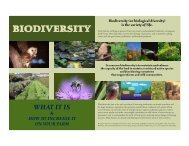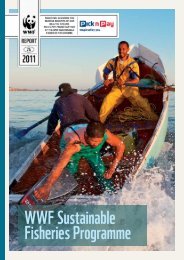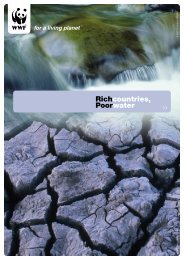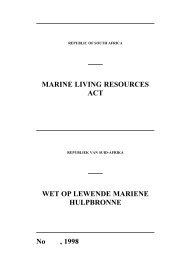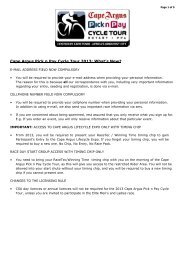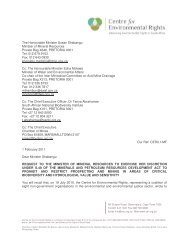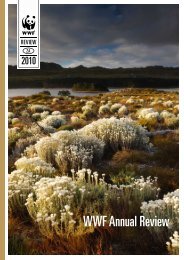State of Management of South Africaââ¬â¢s ... - WWF South Africa
State of Management of South Africaââ¬â¢s ... - WWF South Africa
State of Management of South Africaââ¬â¢s ... - WWF South Africa
- No tags were found...
You also want an ePaper? Increase the reach of your titles
YUMPU automatically turns print PDFs into web optimized ePapers that Google loves.
STATE OF MANAGEMENT OF SOUTH AFRICA’S MARINE PROTECTED AREASOrganisational StructureSANParks has divisions for Parks, Conservation Services, Tourism and Marketing, andPeople and Conservation. Parks and Conservation Services are directly involved in themanagement <strong>of</strong> MPAs. The Parks division is responsible for the operational management <strong>of</strong>National Parks. The management structure within each national park comprises <strong>of</strong> a parkmanager, senior section rangers, section rangers and field rangers. The ConservationServices division provides the services needed to manage the national parks, and isconcerned with the sustainable use and conservation <strong>of</strong> biodiversity.Park Planning and Development, a unit within Conservation Services, is responsible formanagement plans and park system design. One <strong>of</strong> the purposes <strong>of</strong> this unit is to facilitatethe establishment <strong>of</strong> MPAs adjacent to national parks and to consolidate those intoSANParks, ensuring that priorities are set, all available staff are used to best effect, budgetsare set and managed, and funds required are sourced.Scientific Services, another unit within Conservation Services, consists <strong>of</strong> research teamsthat co-ordinate environmental monitoring programs. The team located in Rondevlei includesone marine biologist and one marine ecologist and is involved in monitoring and research inTsitsikamma National Park MPA. The Cape Research Centre, situated in Table MountainNational Park, was established in 2008. MPAs are one <strong>of</strong> the focus areas in which the Capenode aims to advance knowledge, influence research, and evaluate and monitorconservation performance. SANParks also conducts social science research from its twocentres in Kimberley and the Kruger National Park. This research and monitoring focuses onthe interface between people, parks and conservation and is made available to managers toinform decisions.The People and Parks division have three key functions that are important for MPAmanagement. These are:to build understanding and support for biodiversity conservation within communitiesliving in and around national parks, and to improve community access to nationalparks for cultural, spiritual and recreational purposes (Park Forums have beenestablished);to conceptualise, plan, strengthen and oversee implementation <strong>of</strong> cultural resourcemanagement and indigenous knowledge in all national parks;to organise environmental education programs, with extra attention going to rural andpoor communities (day programs for schools, the Kids in Parks programme, Imbewuwilderness camping program for <strong>South</strong> <strong>Africa</strong>n youth leaders, and programs oncalendar days like marine week are organised).A Marine Working Group has also been established within SANParks. The Marine WorkingGroup is attended biannually by park managers and conservation managers (Parks division)and is chaired by the Marine co-ordinator (Conservation services).SANParks receives additional support through a World Bank funded program focussed onthe expansion and the consolidation <strong>of</strong> Addo Elephant National Park and the Garden RouteNational Park.Pg 34



